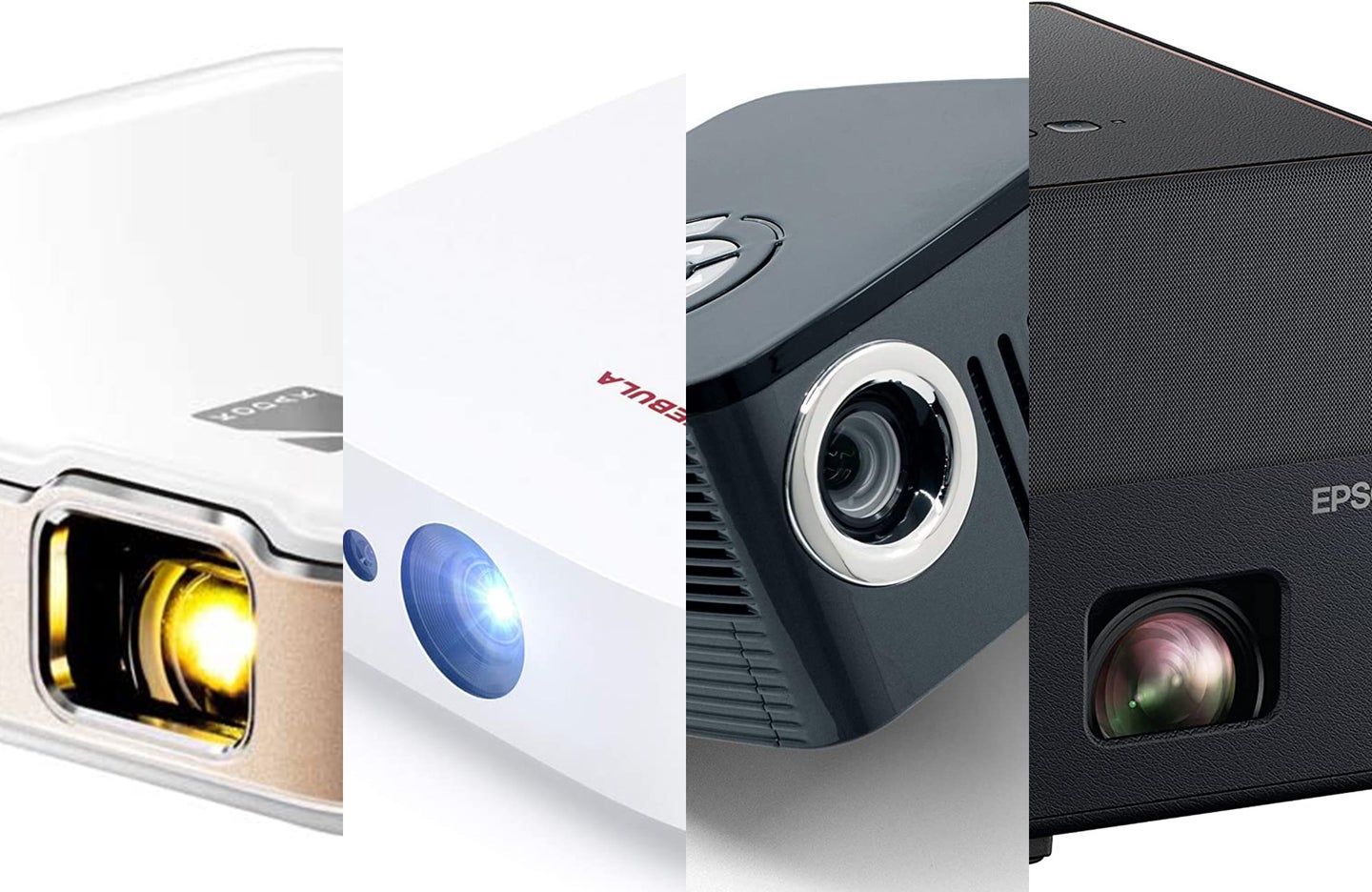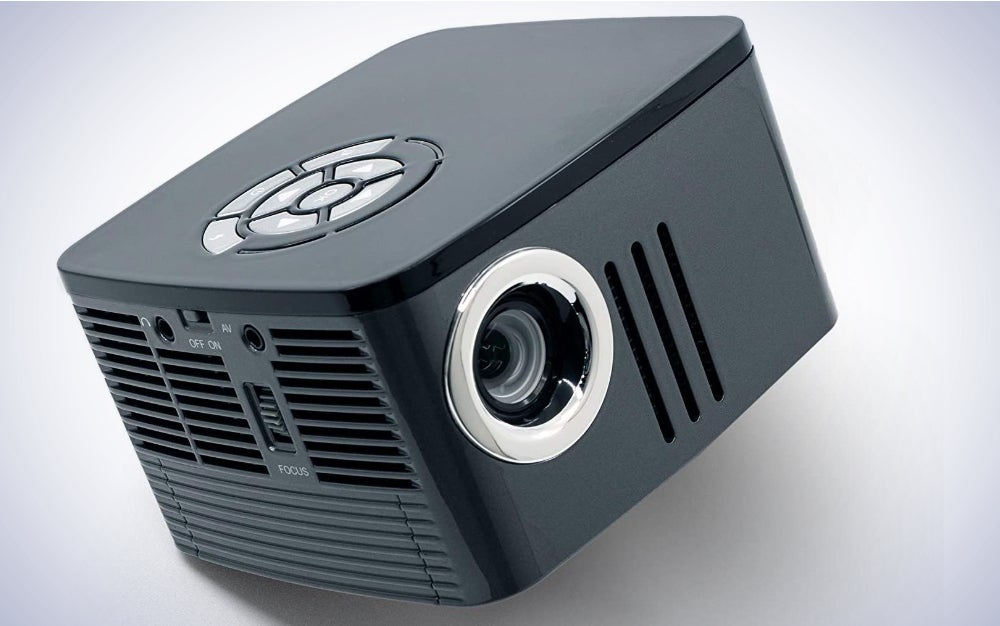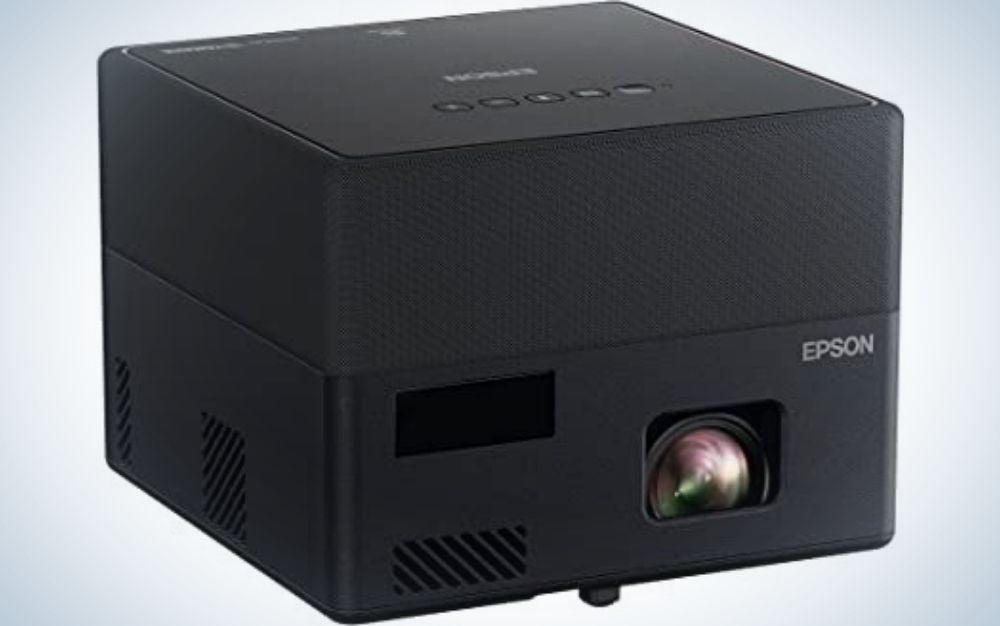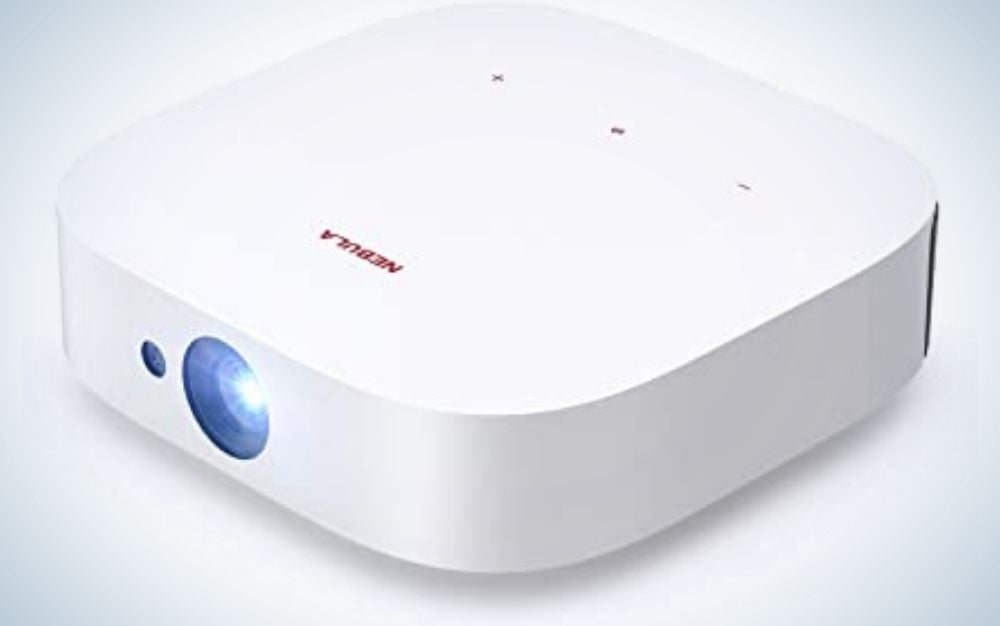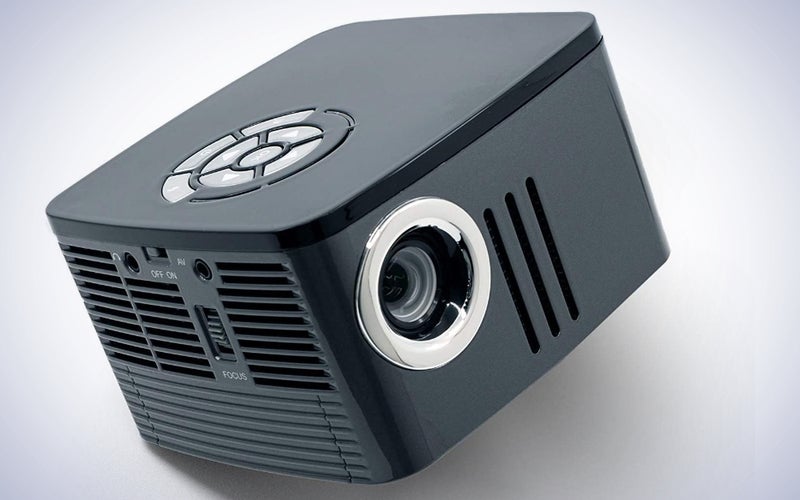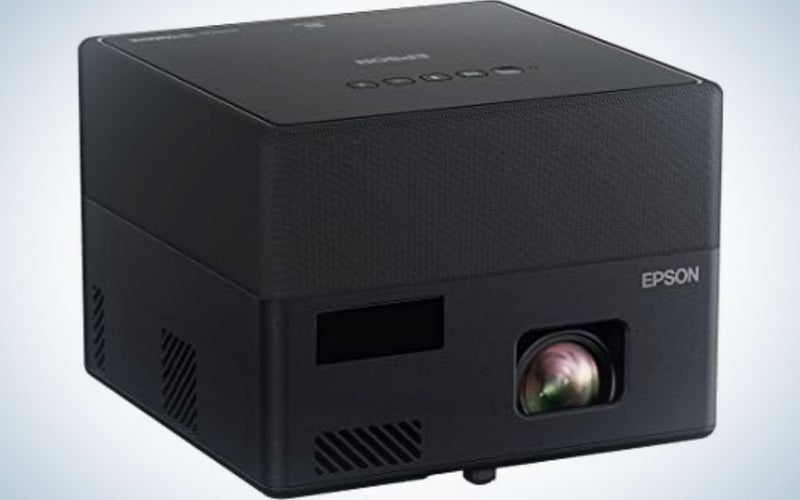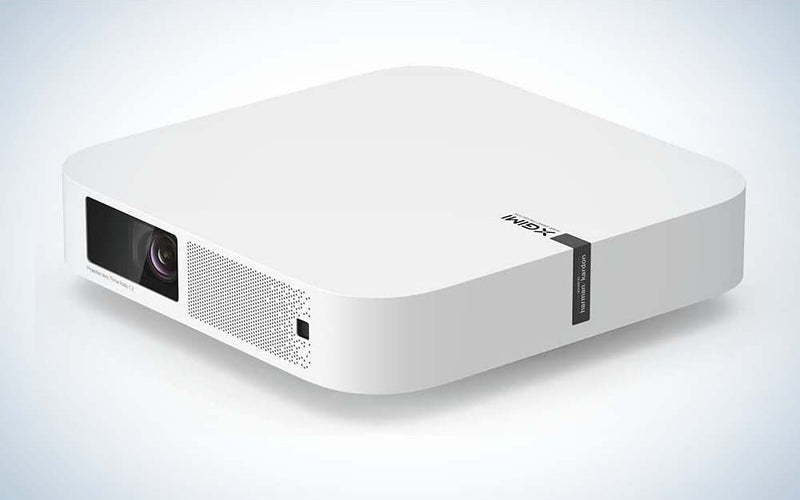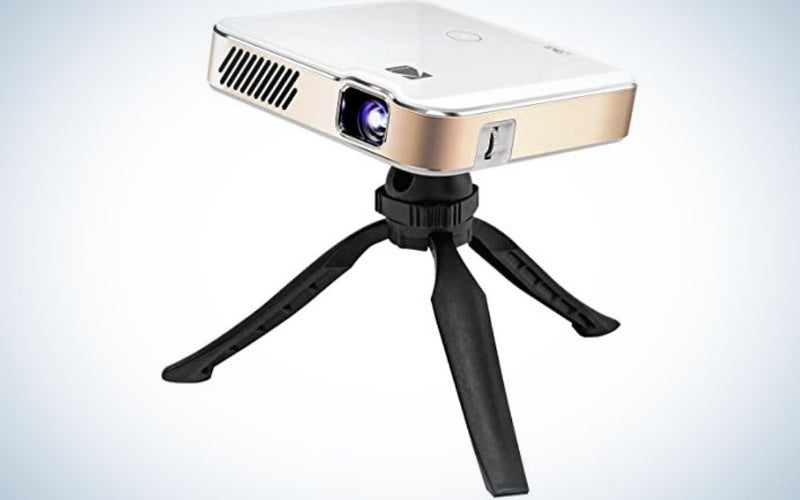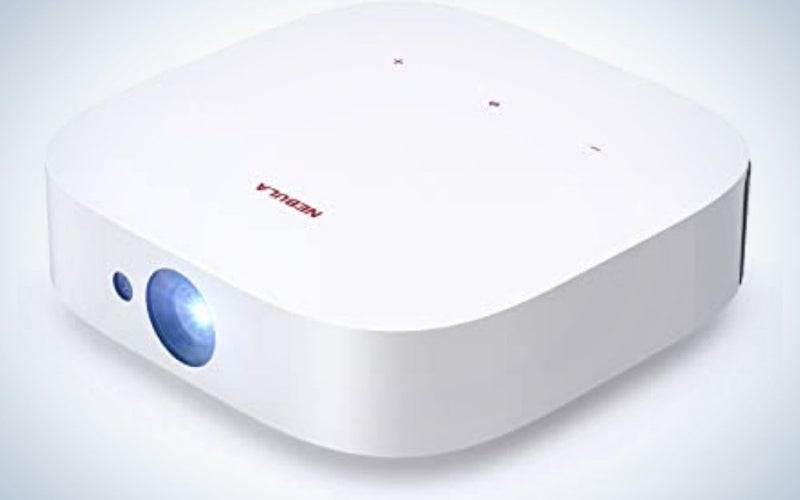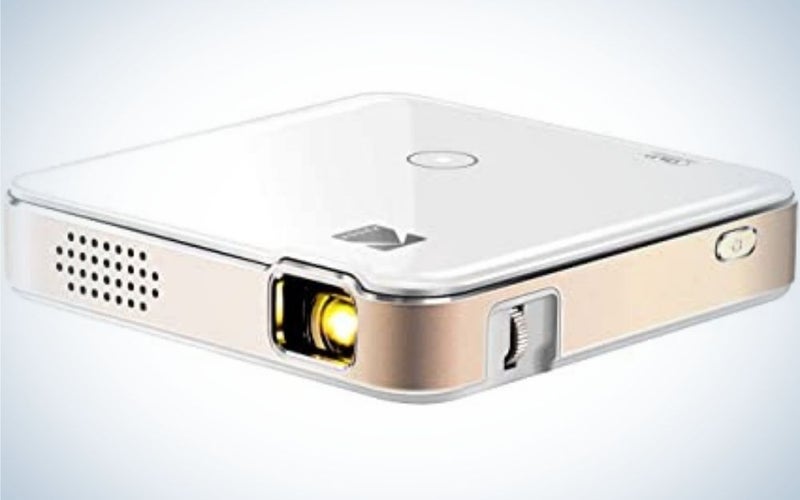We may earn revenue from the products available on this page and participate in affiliate programs. Learn more ›
Mini projectors strike a balance between size, features, price, and image quality. Is it easy to pack big entertainment in a small package? Nope, so when purchasing a mini projector, it’s important to manage your expectations. These units will never match the brightness, resolution, color saturation, contrast, or picture size you get from a full-size projector. On the other hand, try slipping one of those 20-pound monsters into your carry-on bag or using it in a small office or a dorm room. Ideally, the best mini projectors weigh a few pounds or less—sometimes much less—but are bright enough for presentations and to display photos, spec sheets, or whatever else you’d like.
These small entertainment units often include built-in batteries for truly portable play, and some have Android TV functionality for easy streaming. Integrated speakers are common, and there are often HDMI and USB ports for external media like Blu-ray players, set-top streaming boxes, or USB streaming sticks. Finding the best mini projector that meets your priorities isn’t always easy, so we’ve gathered six of the best mini projectors while also providing some insight into what to look for when you’re shopping.
- Best overall: AAXA P7 Mini Projector
- Best for movies: Epson EpiqVision Mini EF12
- Best for gaming: XGIMI Elfin Mini Projector
- Best pocket-sized: Kodak Luma 450
- Best for travel: Anker Nebula Solar
- Best budget: Kodak Luma 150
How we chose the best mini projectors
When selecting the best mini projectors to include in our recommendations, we relied on our experience with home projectors and we reached out to professionals in the TV and AV worlds to discuss their favorites—as well as the types of specs they care about when shopping. We read trade journals and websites and sifted through online reviews and comments to get the impressions of typical users. We narrowed our selection of projectors down to 10, focusing first and foremost on how the unit balanced image quality against its small, portable size. Color, contrast, and resolution were considered, as were size and weight. Price was an important factor, especially in terms of “bang for your buck,” and additional features—like built-in streaming apps, batteries, and speakers—were evaluated as well.
The best mini projectors: Reviews & Recommendations
A little more compact than some portable projectors, while not as limited in features as a pico projector, the best mini projectors are all-in-one entertainment.
Best overall: AAXA P7 Mini Projector
AAXA
Why it made the cut: This small, light projector ticks all our boxes with a native 1080p picture, reasonably bright lamp, built-in battery, and an on-board speaker.
Specs
- Brightness: 600 lumens
- Size: 1.85″ x 1.73″ x 1.06″
- Weight: 1.48 pounds
Pros
- Native 1080p picture
- Included rechargeable battery
- Lots of ports
Cons
- Not 4K
There’s a reason the AAXA P7 Mini Projector is part of our projector coverage. This projector’s DLP lamp delivers a full 1920 x 1080 picture, and its high contrast level produces deep blacks and colors with nice saturation. HDMI and USB-A ports connect the unit to external media players (so don’t forget those HDMI cables).
Its internal battery lasts for 1.5 hours. The internal speaker sounds good, despite being light in the low end. With a brightness of 600 lumens, you get a 120-inch picture before noticing any significant loss of quality.
There are few cons with this mini projector: To watch content from streamers, you’ll need to either connect an HDMI cable or plug in a Google Chromecast. It also doesn’t support 4K. It’s frustrating but not a deal-breaker, given how many other excellent features are present.
Best for movies: Epson EpiqVision Mini EF12
Epson
Why it made the cut: Superior contrast, a relatively bright lamp, and advanced imaging technology work to deliver what’s by far the best-looking movies you’ll see from any other projector on this list.
Specs
- Brightness: 1000 ANSI Lumens
- Size: 6.9” x 6.9” x 5”
- Weight: 4.7 pounds
Pros
- Native 1080p resolution
- Supports 4K media (down-converted to HD)
- 200,000:1 contrast ratio
- Built-in Android TV
- Excellent speakers
Cons
- A bit heavy by mini standards
- Expensive
The EpiqVision Mini EF12 is more expensive than most other mini projectors, but that’s the trade-off for a positively cinematic movie-watching experience. With a native Full HD 1080p resolution and 1,000-ANSI lumen MicroLaser light source, the unit projects a sharp 140-inch picture. Three-chip LCD technology displays 100 percent of the RGB color range, while high contrast and adaptive color correction deliver shadows full of detail and saturated colors that positively pop.
Built-in Android TV provides access to a full suite of streaming apps, and the EpiqVision Mini has two HDMI inputs for external players. A 5-watt Yamaha speaker delivers robust and clear audio.
Unfortunately, this Android projector doesn’t have an internal battery, so don’t expect to use it without having access to AC power. It’s also a chunkier piece of gear than many mini projectors on this list—this isn’t dropping into anyone’s pocket. And, again, the price—close to $1,000, compared to all our other sub-$500 choices—might make it a tough buy for anyone watching their budget. But if you prioritize your movies above all else, there’s a reason this is one of our favorite home theater projectors.
Best for gaming: XGIMI Elfin Mini Projector
XGIMI
Why it made the cut: The XGIMI Elfin mini projector enhances gaming by providing a crisp picture, a 3D mode, superior audio quality, and low latency.
Specs
- Brightness: 800 ANSI lumens
- Size: 7.56” x 7.63” x 1.89”
- Weight: 4.41 lbs.
Pros
- 1920 x 1080 resolution
- Features a 3D mode
- Built-in Android TV
- Comes with two Harman Kardon speakers with DTS and Dolby Atmos sound
Cons
- Doesn’t work with iOS
- Some users experienced difficulties with WiFi connection
The XGIMI Elfin Mini Projector is designed for both cinephiles and gamers. Its native Full HD 1080p resolution and 800-ANSI lumen light combine for a crisp 150-inch picture. This pick also comes with built-in Android TV, giving users access to over 5,000 apps, including Google Play, Prime Video, and Disney+.
What sets the Elfin apart is that it comes with a 3D mode that can enhance the gaming experience. This mini projector also features two 3-watt Harman Kardon speakers that work with DTS and Dolby to provide atmospheric sound. The Elfin is also equipped with an autofocus mode, and the low latency of 26.5 milliseconds is another selling point for gamers.
For those looking for a projector with wireless audio, the Elfin connects via Bluetooth 5.0, as well as WiFi, USB, HDMI, and headphones. With its slim profile and at just 4.5 pounds, it’s also easy to tuck this projector into a backpack for travel. And it’s priced lower than some other options. If you’re looking for a larger model, check out our guide to the best projectors for gaming.
Best pocket-sized: Kodak Luma 450
KODAK
Why it made the cut: With native 1080p resolution, this pint-size player delivers a much better picture than you usually get from such small projectors.
Specs
- Lumens: 200 ANSI lumens
- Size: 4.9” x 4.9” 1.26”
- Weight: 9 ounces
Pros
- 1920 x 1080 resolution
- 4K compatible (down-converted)
- Keystoning
- 3-hour battery life
Cons
- Not very bright
- Tinny audio
Kodak’s tiny Luma 450 delivers full 1080p resolution with the ability to accept 4K signals (down-converted to HD). The DLP projector’s 200 lumens aren’t high-performance, but good color management and a 3,500:1 contrast ratio help to achieve a decent picture up to about 100 inches. It’s important, however, to make sure the room is nice and dark, as too much ambient light leads to washed-out colors and a loss of details in the shadows.
The Android Smart OS is included, and streaming apps can be downloaded directly to the projector. You can also cast from this wireless projector directly from your smart device or computer, or plug a media player into the projector via HDMI. It also accepts USB streaming sticks and is a great mini projector for iPhone.
The Luma 450’s battery is reported to last three hours and most users seem to get about 2 1/2 hours of life before plugging in—impressive! Less impressive is the small 1-watt speaker system; the audio lacks any sort of body and clarity sometimes suffers during chaotic scenes (luckily, there’s a 3.5mm jack so you can connect to a beefier sound system).
Best for travel: Anker Nebula Solar
NEBULA
Why it made the cut: Lightweight and featuring built-in Android TV, this battery-powered projector travels easily.
Specs
- Brightness: 400 ANSI Lumens
- Size: 7.56” x 7.57” x 2.15”
- Weight: 2.8 pounds
Pros
- Up to three hours of battery life
- Built-in Android TV
- Native HD resolution but can accept 4K inputs
Cons
- Picture suffers in ambient light
- Color accuracy could be better
This 3.1-pound, rechargeable, battery-powered DLP projector loves life on the road. You’ll get 1 1/2 hours in Standard mode and an excellent 3 hours in Battery mode—albeit with a dip in brightness. The built-in Android TV includes apps to connect to all the major streaming services, so no external media is necessary (you will, however, need access to a Wi-Fi network and a Google account). Built-in dual 3-watt speakers can handle Dolby Digital Plus encoded audio, though the sound quality could be better.
The Solar Portable accepts 4K signals and down-converts them to the projector’s native 1080p resolution. In HD mode, colors exhibited a subtle nuance—though they were sometimes a bit off—and shadows maintained their detail even in darker scenes. While this 4K mini projector is bright enough to deliver a nice 180-inch image, don’t expect to go much larger without the picture softening.
Again, it’s about striking a balance. Other projectors deliver a nicer picture but don’t have as much functionality when traveling. For more options, explore our guide to the best outdoor projectors.
Best budget: Kodak Luma 150
KODAK
Why it made the cut: This inexpensive and ultra-small projector is a great way to share presentations, photos, or videos.
Specs
- Brightness: 60 ANSI lumens
- Size: 3.1” x 3.1” x 0.87”
- Weight: 7.8 ounces
Pros
- Small and light
- Full-size HDMI input
- microSD card slot
Cons
- Not very bright
- Not full HD
Kodak’s Luma 150 is a fun, budget-friendly way to share content from your smartphone. Send video over a full-size HDMI cable, or cast your content from connected devices. The projector also accepts microSD cards.
At first blush, the 60-lumen DLP projector doesn’t seem very bright. And its 854 x 480 resolution isn’t the stuff of blockbusters. But this mini movie projector isn’t meant to be your primary choice. The Luma 150 instead makes a convenient, very inexpensive tool for sharing photos at get-togethers, watching movies in the backseat of the car, or delivering presentations at a conference on a screen that’s significantly bigger than the one on your phone, tablet, or laptop.
The battery lasts about two hours and the unit can also be plugged in, making it a good option for a bedroom projector. This cheap projector has a speaker, but you’re better off using headphones or a small, portable speaker if watching videos with other people.
Things to consider before buying a mini projector
It’s not easy for something that potentially fits in your palm (or at least can be easily carried with one hand) to throw a picture that’s around 100-200 inches from corner to corner, in 720p or 1080p, with accurate colors and decent shadow detail. Here are the specs to watch for as you shop:
Brightness
ANSI lumens describe how much light a projector creates, which determines how bright and large your picture will be—especially in less-than-ideal situations where you can’t achieve a completely dark room. Brightness levels of around 200 to 500 ANSI lumens are common, with picture sizes of around 80-120 inches. That said, there are some mini projectors that can achieve much brighter pictures than that.
Chip
Projectors use imaging chips to create a picture, and there are three types of them: DLP, LCD, and LCoS. DLP chips find a home in units at all different price points and deliver average contrast and nice color. LCD chips can be found on budget to mid-range projectors and often have better color than DLP projectors, but contrast ratios sometimes suffer. Lastly, LCoS chips are used in mid-range to high-end projectors; they tend to deliver the best picture quality overall but, not surprisingly, cost more and don’t show up in budget units.
One last thing to know about chips: Single-DLP projectors, which comprise most budget-priced units, sometimes suffer from “the rainbow effect.” This is when bright objects on the screen leave very quick, multicolored pixel trails behind them. With thousands upon thousands of single-DLP projectors sold, it’s obvious that most people don’t even notice them—or aren’t bothered. But if you have an opportunity to test out a single-DLP projector at a store, consider doing so in order to gauge how you feel about the rainbow effect.
Pico and palmtops
There’s mini, and there’s mini. Pico projectors, also sometimes called pocket projectors, are about the size of a smartphone. They’re extremely portable, of course, but their pictures rarely match the brightness or quality found on bigger machines. Palmtop projectors are larger and brighter than pico projectors, with more connections, but still light enough to drop into a bag for travel or presentations. Many models also connect with smartphones, making them ideal cell phone projectors.
Power
Many mini projectors run on internal batteries for at least a couple of hours, making them even more portable. That said, it’s not enough juice to binge an entire series or watch some of the longer Marvel movies. Luckily, mini projectors also come with AC cords so when you’re at home, in an office, or at a friend’s place, you can just plug them in.
Screens
Projectors shine light on a surface that reflects the light back to our eyes. That means using a projector with a plain, white wall isn’t going to deliver the best picture because too much light gets absorbed by the paint. For the optimal viewing experience, you need to buy a screen—which can run from around $25 to a little over $100, depending on sizes, stands, and accessories. These have reflective surfaces that increase perceived brightness, contrast, and color saturation—all of which are especially important when using a mini projector, which is likely already hobbled by a dimmer light source.
Audio
Because they’re built for portability, mini projectors often include speakers. Three or more watts can generally fill a small space, but volume isn’t everything. Ensure the speakers produce clear audio to separate voices from background noise or music in busy scenes. Decent bass response will contribute to the sound’s fullness, too. Many mini projectors also include an audio-out jack for using external speakers.
FAQs
Q: Are mini projectors worth buying?
Mini projectors are worth buying if you put a premium on size and portability. They’re small, lightweight, and often include features like battery power, built-in Android TV, and speakers. However, they sacrifice picture quality and brightness to achieve those other ends. If you want something you can keep set up in your personal media room, a mini projector isn’t the best choice.
Q: Can you watch Netflix on a mini projector?
You can watch Netflix on a mini projector by connecting a set-top streaming box, like an Apple TV or Roku, via HDMI, or some other streaming stick/media folder through the USB port. Some mini projectors have internal Android TV, but the Netflix app isn’t always compatible. It’s important to confirm compatibility ahead of time.
Q: How much does a mini projector cost?
Mini projectors can range in price depending on the number of features, brightness, and quality of the image. Expect to pay around $200 at the very low end for basic units and as much as $800 for projectors with high-quality, cinematic visuals.
Q: Is a projector better than a TV?
Sometimes a projector is better than a TV, but sometimes it’s not. It depends on what sort of viewing experience you want to have, and where you plan on having it. Projectors are usually capable of much bigger pictures—imagine a full-size unit delivering 300 inches of Marvel movie mayhem! But if you don’t need that big a screen, or you simply don’t have room for it, maybe a large, flat-screen TV will suit you better. Projectors can often offer much better contrast than TVs, but that’s only if they’re in a dark room. If the ambient light is an issue, projectors might run into trouble. Projectors need enough space to “throw” their image in order for it to achieve its maximum size—is your room deep enough to allow that? On the other hand, projectors capable of displaying a 100-inch picture are much easier to take on the road with you than a 100-inch TV! In the end, deciding which is best comes down to your own lifestyle and movie-watching interests.
Q: How much do mini projectors cost?
The cost of mini projectors can range from under $50 for budget options to more than $1,000 for premium versions with high picture quality, superior audio, and built-in access to Android TV and more than 5,000 apps. You can find versions that work easily with your iPhone or more sophisticated models that feature a 3D mode.
Final thoughts on the best mini projectors
- Best overall: AAXA P7 Mini Projector
- Best for movies: Epson EpiqVision Mini EF12
- Best for gaming: XGIMI Elfin Mini Projector
- Best pocket-sized: Kodak Luma 450
- Best for travel: Anker Nebula Solar
- Best budget: Kodak Luma 150
Mini projectors almost never live up to the specs of larger, more permanent units—but they cost less and travel easily. Anyone looking to purchase a mini projector needs to first accept that reality before deciding which unit suits them best. After that, it comes down to priorities. If you want a great picture and don’t care about much else, Epson’s EpiqVision Mini EF12 delivers a cinema-like picture. On the other hand, the AAXA P7 Mini Projector trades off some brightness, and a bit of image quality, for portability. It features a battery and costs much less. In striking that balance, in embracing what’s great about mini projectors, the AAXA P7 edged out the Epson for our top pick.
Why trust us
Popular Science started writing about technology more than 150 years ago. There was no such thing as “gadget writing” when we published our first issue in 1872, but if there was, our mission to demystify the world of innovation for everyday readers means we would have been all over it. Here in the present, PopSci is fully committed to helping readers navigate the increasingly intimidating array of devices on the market right now.
Our writers and editors have combined decades of experience covering and reviewing consumer electronics. We each have our own obsessive specialties—from high-end audio to video games to cameras and beyond—but when we’re reviewing devices outside of our immediate wheelhouses, we do our best to seek out trustworthy voices and opinions to help guide people to the very best recommendations. We know we don’t know everything, but we’re excited to live through the analysis paralysis that internet shopping can spur so readers don’t have to.
